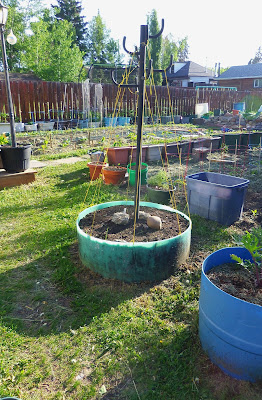Welcome, June! It has been a cool, cloudy start, but today is a comfortable 21 degrees C and sunny.
The last 3 weeks have been filled with garden-related tasks. Almost everything is planted now and the next step is setting up trellises and stakes for the things that will need them (tomatoes, beans with runners, etc.)
Wildfires in the region (as well as in the Prairie provinces) are, unfortunately, already raging. A number of evacuees from a wildfire 80km south of our town have come here to wait it out. The air has generally been clear, though yesterday the air was hazy with smoke.
In the garden, volunteer sunflowers (hundreds of them) and tomato seedlings (dozens of them) have been popping up everywhere. We actually transplanted some of the volunteer sunflowers into some of the raised beds. My fingers are crossed that they will be single-stem/single-bloom sunflowers and not the branching, multi-bloom kind (which would interfere with the crops growing in the raised beds). Here is one small section of one of the gardens, where volunteer sunflowers are growing:
.
..and some more coming up in a planter...
There are 87 tomato plants in the gardens, raised beds, and free-standing containers. That's a record. I started more varieties than usual this year and wanted to grow them all. Many are lined up against the north fence, along with a few peppers, dahlias, and marigolds in pots. I gave some transplants to R's brother and then was able to sell the remaining ones. It's nice to make a bit of money from the transplants; it helps offset the cost of potting soil, fertilizer, and other gardening supplies.
Some of the early/early-midseason tomato varieties already have flowers: Taxi, Katja, Bellestar, and Japanese Black Trifele (pictured below).
Cabbage (mostly Copenhagen, and a few Jersey Wakefield) is planted, as are the fresh beans (Giant Roma bush, Galopka, and Provider - planted May 30th).
The dry beans, listed below, were planted May 28-29. Some varieties take up half a raised bed, and some were planted in window boxes, holding just 6-10 beans. My attempt to keep as many varieties viable as possible.
Flagg (d/pole bean)
Yer Fasal (d/bush) - Turkish heirloom
Butterscotch (d/bush with runners)
Tene’s Beans (d/bush)
Beka Brown (d/bush)
Coco Jaune de Chine (d/bush)
Orca (d/bush)
Fiesta (d/bush)
Ruckle (d/bush)
Tiger Eye (d/bush with runners)
Black Coco Beans – (d/bush) - older seeds - 2018
Canadian Wild Goose (d/bush) - older seed – 2016
Blue Jay (can be used as d/b or sn/b) – older seed - 2014
Ireland Creek Annie (d/bush)
Painted Pony (d/bush)
Arikara Yellow (d/bush)
Anasazi (d/bush with runners)
Light Red Kidney (d/bush)
Zuni Shalako (d/bush)
Speckled Algonquin (large d/bush) - old seed – 2013
The varieties of winter squash on the go this year are Galeux D'Eysines (raised bed), Lower Salmon River (south garden), Bush Delicata (a new variety for me - planted in large containers), and Butterbush (planted in raised beds and the east garden). They were transplanted in late May. If it decides to germinates, I'll also have some Table King Acorn to find spaces for!
Odds and ends... Early Charm asters, marigolds, Unwin's Mix dahlias, Russian Mammoth sunflowers, a variety of kale, parsley, Swiss Giant Pansy, nasturtiums, cosmos ('Sensation Mix'), lavatera ('Pink Blush'), and a variety of lettuces have been planted around the garden. Transplants from the nursery include Pineapple Mint, Mojito Mint, Pineapple Sage (smells heavenly), Spanish lavender, and catnip.
The deer returned mid-May to snack on the strawberry plants, so R. had to put up plastic netting around the strawberry bed.
A new spot we're planting tomatoes, peppers, herbs, etc...
Pictures from around the garden (click to enlarge):
The north garden
Pansies
Sage
Along the driveway...
New spot for rhubarb...
...and some spare ones to plant.
The garlic patch
Trellis for the dry pole beans (possibly much too short, but we'll see!)
The dill patch (I hope I don't have to thin this...)
A bit of kale
Swedish Red cooking peas
Lou in a sunbeam. The transplants are gone, and she finally has her plant room back.


































